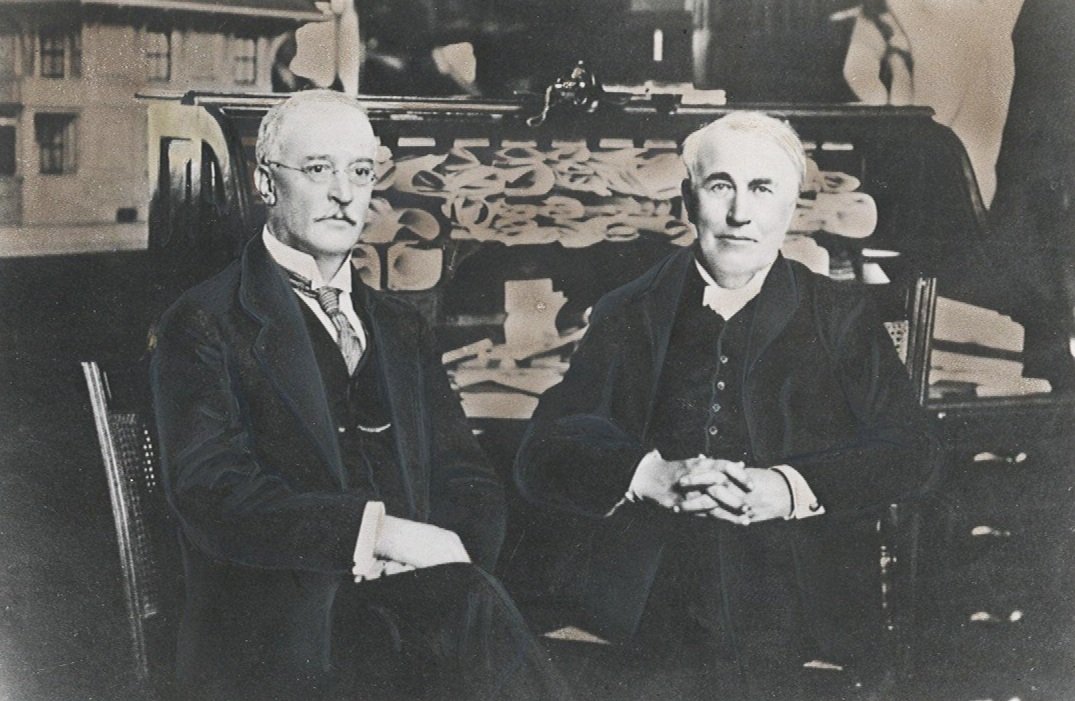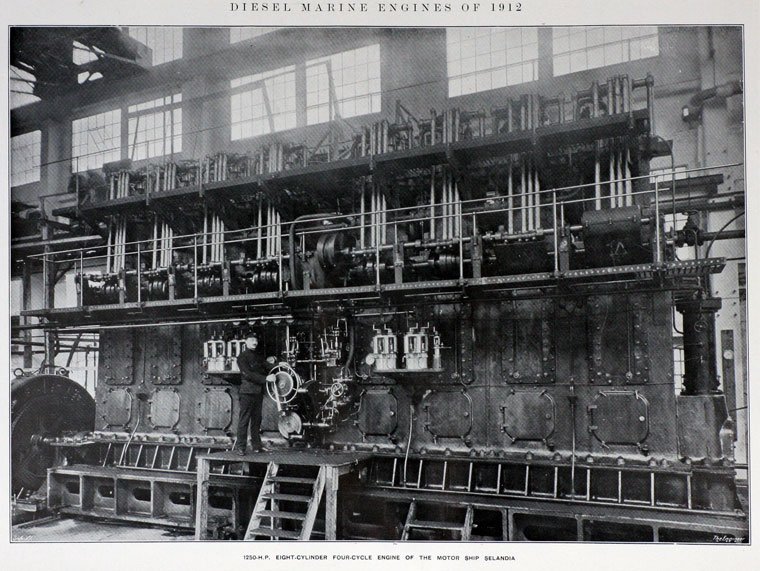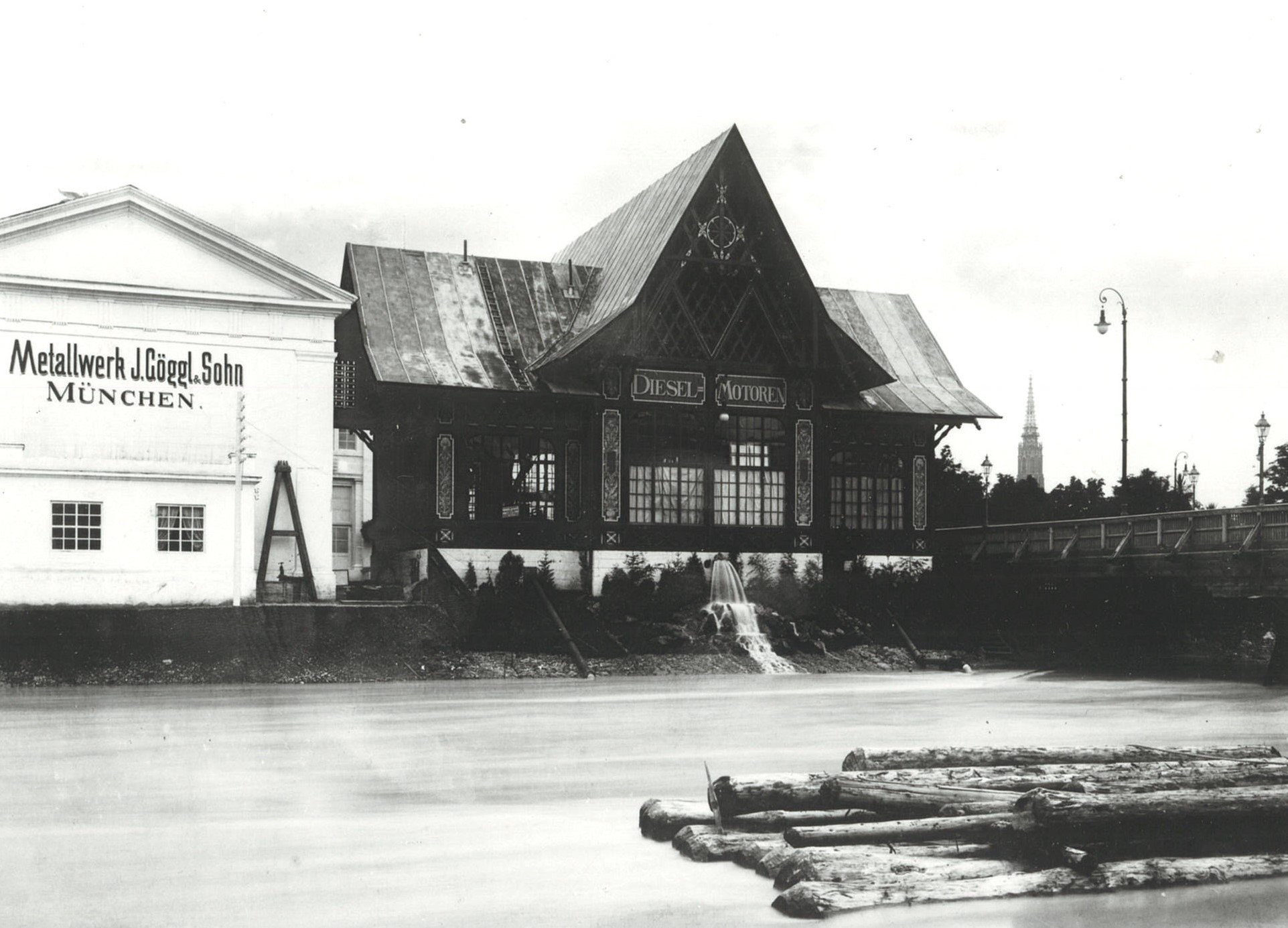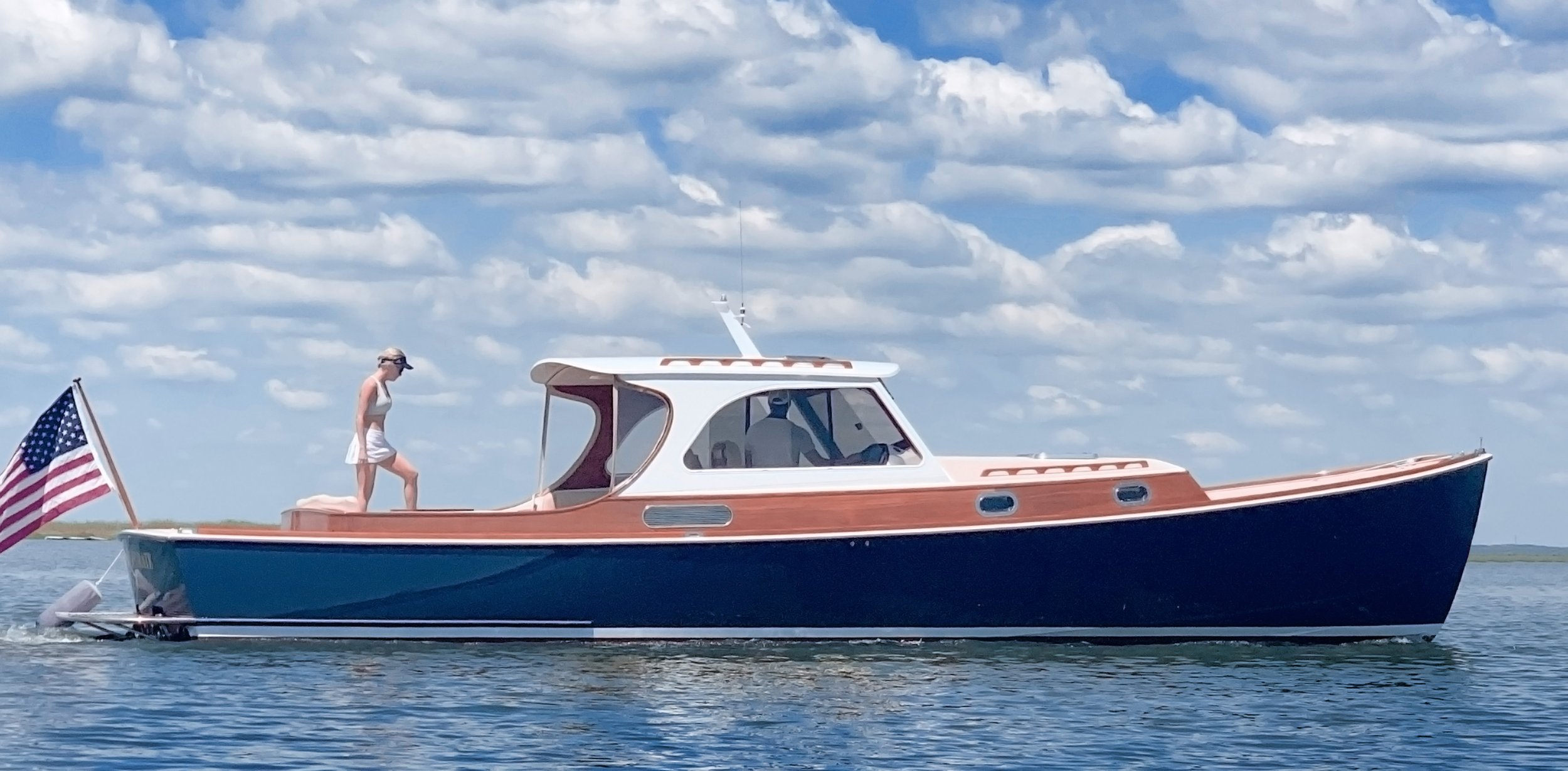
EXPLORE THE MYSTERIOUS CASE OF RUDOLF DIESEL
-
After rising from an impoverished European childhood, Diesel had become a multi-millionaire with his powerful engine that does not require expensive petroleum-based fuel.
-
Diesel became an international celebrity. His friends and enemies around the world included some of the most powerful political figures and industrialists of the 20th Century.
-
Diesel engines afford far greater range, the fuel is not flammable, and is much less noxious. Gasoline engines start with an electric spark, but not Diesel. The diesel engine was so efficient it ushered in the end of the Steam Age.
-
The Diesel engine became well-known after Rudolf Diesel and his partners displayed four engines at the 1898 Munich Exhibition.
-
The huge, grand and sumptuous Villa Diesel at 32 Maria-Theresia Strasse was built for Rudolf Diesel from 1899 to 1901 in the neo-baroque style. The architect was Max Littmann.
EXPLORE THE VILLA
(Courtesy of the Historical Archive MAN Augsburg) -
Diesel’s hat and neatly folded coat were found on the promenade deck at the stern of the SS Dresden. The Dutch steamer Coertzen reported the discovery of Rudolf Diesel's corpse in the Scheldt estuary.

After rising from an impoverished European childhood, Rudolf Diesel had become a multi-millionaire with his powerful engine that does not require expensive petroleum-based fuel. In doing so, he became not only an international celebrity but also the enemy of two extremely powerful men: Kaiser Wilhelm II of Germany and John D. Rockefeller, the founder of Standard Oil and the richest man in the world.
As electric lighting began to replace kerosene lamps, Rockefeller’s bottom line depended on the world’s growing thirst for gasoline to power its automobiles and industries.
At the outset of this new age of electricity and oil, Europe stood on the precipice of war. Rudolf Diesel grew increasingly concerned about Germany’s rising nationalism and military spending. The inventor was on his way to London to establish a new company that would help Britain improve its failing submarine program when he disappeared.
RUDOLF DIESEL

-
Martha Flashe was a German governess working in Paris when she met Rudolf Diesel. They married in 1883.
-
Kaiser Wilhelm II ruled the German Empire from 1888 until his abdication in 1918. He was the last German Emperor.
Photo: Originally taken by Court Photographer T. H. Voigt of Frankfurt, 1902. Public domain.
-
Thomas Edison (1847-1931) was an American inventor of devices including the phonograph and versions of the electric light bulb. Rudolf Diesel observed the distinction that Edison’s inventions typically consumed power while the Diesel engine produced it. In 1912, Edison declared the Diesel engine to be “one of the great achievements of mankind.”
Photo: Louis Bachrach, Bachrach Studios, restored by Michel Vuijlsteke. © United States Library of Congress. Public domain.
-
Adolphus Busch (1839 – October 10, 1913), the German-born “Man from Zaint Louee” moved to St. Louis, Missouri in 1857 where he entered the brewing business with Eberhard Anheuser and eventually married Anheuser’s daughter Lilly in 1861.
In 1879 the partners renamed the brewing company Anheuser-Busch. Adolphus acquired the exclusive North American rights to the Diesel engine in 1898, initially for use in his brewing business. In 1911 he founded Busch-Sulzer Brothers Diesel Engine Company. Busch-Sulzer tried to hire Chester Nimitz in 1913 but Nimitz, a Diesel and submarine expert, turned down the offer to remain with the US Navy.
Photo: Created before 1913. Public domain.
-
Friedrich Alfred Krupp (1854 - 1902) was a German steel magnate who inherited the Krupp Company from his father in 1887. He shifted the emphasis of the company from the supply of iron and steel to the manufacture of industrial equipment and munitions.
In 1893, Krupp offered Rudolf Diesel an annual salary of 30,000 German marks to pursue a commercially viable heat engine based on Diesel’s theories. The firm supplied steel all over the world, including for the Chrysler Building in New York, and was later instrumental in German rearmament under the Nazi regime.
Painting: Portrait by Ludwig Noster, 1896. Public domain.
-
Mannequin of Chester Nimitz showing the hand he injured in an accident during his visit to a Diesel manufacturing plant in Germany in 1912.
From the USNA museum exhibit "Victory in the Pacific"
-
John D. Rockefeller (1839-1937) co-founded Standard Oil in 1870 and by the end of the century was the richest man in the world. In 1912, Rudolf Diesel declared that his engine could break the American fuel monopoly.
-
Winston Churchill attending German Army maneuvers with Kaiser Wilhelm II, 1906.
(Photo Getty Images)
-
Rudolf Diesel and Thomas Edison in America, May 1912.
Photo: Courtesy of the Historical Archive MAN Augsburg.
-
Admiral John “Jackie Fisher” (1841-1920) was known as a naval innovator. Fisher was appointed First Sea Lord in 1904 (a military post, different from and subordinate to the First Lord of the Admiralty, a political post) then retired in 1910.
In 1914, Churchill, then First Lord, called Fisher back to service as his First Sea Lord. Fisher helped to modernize the Royal Navy prior to the Great War and was early to recognize the value of submarines.
Photo: Painting by Sir Hubert von Herkomer, 1914. Public domain.
-
Grand Admiral Alfred von Tirpitz (1849-1930) authored Risk Theory, the German Empire’s strategy to develop a world-class navy that could threaten Britain’s mastery of the seas. Tirpitz advocated for Germany to engage in unrestricted submarine warfare during the Great War.
Photo: 1903, © German Federal Archive, CC BY-SA 3.0 de
-
E.D. Meier (1841-1914) advised Busch on the acquisition of the Diesel license for North America. Born in St. Louis to German emigrants, Meier fought for the Union Army in the Civil War, became an engineer and locomotive expert and served as president of the American Society of Mechanical Engineers from 1911-12.
-
Winston Churchill (1874-1965) served as First Lord of the Admiralty from 1911-1915 and was ultimately responsible to ensure the preeminence of the Royal Navy.
Photo: Churchill in 1904, from The Imperial War Museum, UK. Public domain.
-
Carl von Linde (1842-1934), a pioneer of refrigeration. Linde was a mentor to and early employer of Rudolf Diesel. He continued to support Diesel publicly and financially.
Pictured 1868. Public domain.
-
Emanuel Nobel (1859-1932) in 1888 became chairman of Branobel (Brothers Nobel), the oil producing firm founded by his father and uncles, including his uncle Alfred Nobel who bequeathed the bulk of his estate to establish the Nobel Prizes. In 1898 Emanuel Nobel acquired the exclusive rights for the Diesel engine in Russia and continued to develop the technology.
Painting: Emanuel Nobel by Valentin Alexandrovich Serov, 1909. Public domain.
-
Heinrich von Buz (1833-1918) led Machinenfabrik Augsburg, the firm founded by his father, from 1864-1913.
The “Bismarck of the German Engineering Industry,” he gave crucial support to the development of the Diesel engine at M.A. He also developed the first refrigeration machine for Linde in 1873.
-
Sir Charles Parsons (1854-1931) best known for his invention of the steam turbine in 1884. He exhibited his turbine-powered yacht, Turbinia, at Queen Victoria’s Diamond Jubilee in 1897. His new yacht could make 39 mph, nearly 10 mph faster than any naval ship at the time. Parsons and Diesel became close friends.
Photo: Date unknown. Public domain.

THE DIESEL ENGINE
The second prototype of the Diesel engine completed March 1895 and Diesel’s 1893 patent.
In 1878, Rudolf Diesel attended the lectures of Carl von Linde. Linde explained that steam engines are capable of converting just 6–10% of the heat energy into work. According to Diesel, this ignited the idea of creating a highly efficient engine.
Clessie Cummins’ Diesel Indianapolis 500 Racer (1931)
Dale Evans driving the Diesel-powered race car designed by Clessie Cummins. Evans astounded fans by finishing 13th of forty cars at Indianapolis 500 in 1931. He beat much faster gasoline-powered race cars because this was the first car in history to complete with race without making a single pit stop for fuel.
A Diesel Engine from the Selandia
The enormous 1250 HP diesel engine of the Selandia shown here inside the manufacturing plant of the Danish firm Burmeister & Wain. (Photo 1910)

THE MUNICH POWER & WORKS EXHIBITION OF 1898
-

The Pavillion
The exterior of the Diesel Pavilion where Diesel's manufacturing partners exhibited the Diesel engines.
-

The Interior of the Pavilion
Notice the name Krupp which was one of the Diesel partners.
-

Rudolf Diesel & Colleagues in 1898
Rudolf Diesel (standing centre) and a group his engineers who supported the Diesel exhibit in 1898.


THE SHIPS
-

SS Dresden (1896)
Rudolf Diesel’s hat and neatly folded coat were found by rail of the promenade deck at the stern of the ship.
Painting: Jensen, Alfred; SS 'Dresden', 1915, oil on canvas. Public domain.
-

Coertzen (1884)
Photograph of the Dutch steamer Coertzen that reported the discovery of Rudolf Diesel's corpse in the Scheldt estuary and returned several of his personal items to the Dutch port in Vlissingen.
Photo: Archive & Collection Vereniging Nederlandse Loodsen Sociëteit
-

The MS Selandia (1912)
This Diesel-powered vessel became known as “The ship that changed the world”. Given the lack of smoke stacks and dirty billowing clouds these technological marvels were sometimes described as phantom ships.
-

Doug Brunt's Diesel-Powered Boat (1996)
The author’s boat powered by twin Yanmar 370hp Diesel engines.


